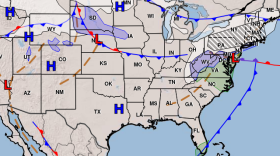Update: Thursday, 5:10 p.m.: About 5,000 customers of Eversource and the New Hampshire Electric Cooperative are still without power in the wake of Tropical Storm Isaias on Tuesday night.
Previous updates continue below:
Update: Thursday, 9:45 a.m.
About 10,000 electric customers are still without power in New Hampshire Thursday morning, two days after Tropical Storm Isaias brought heavy wind and rain to the region.
Most are customers of Eversource and the New Hampshire Electric Cooperative, in the Lakes Region and surrounding areas.
The state's utilities say they've been working around the clock to restore power to tens of thousands of Granite Staters since Tuesday night, when Isaias blew through and brought down tree limbs and power lines around the state.
Scattered outages could persist through Friday.
Update: Wednesday, 5:12 p.m.
More than 20,000 Granite Staters are still without power after Tropical Storm Isaias rolled through the region Tuesday night.
Eversource reported 16,867 customers without electricity, as of 5 p.m. The state's largest utility has restored power to more than 120,000 since the start of the storm.
Eversource customers across New Hampshire were affected. Those still without power included 1,268 in Wakefield, 454 in Peterborough, and 500 in Grantham. In a release, Eversource said it expects to "substantially complete" its restorate effort by Friday night.
New Hampshire Electric Cooperative reported 7,648 outages, including 920 in Jackson, 240 in Alton, and 297 in Acworth.
Update: Wednesday, 10:50 a.m.
More than 2,000 Eversource customers are in the dark in Wakefield, along with more than 1,000 each in Dover and Stoddard. The Electric Co-op reports more than 1,000 outages apiece in Sandown and Jackson.
The storm brought down tree branches onto roadways and power lines. Utilities say restorations may take longer than usual due to coronavirus staffing restrictions. High winds also made it harder to address damage overnight.
"Restoration and assessment efforts are continuing this morning, as NHEC and contractor crews are facing extensive tree damage that has restricted access to many locations," says Electric Co-op spokesman Seth Wheeler in a press release. "Numerous roads remain closed statewide."
Liberty Utilities reports about 400 outages in the Upper Valley, with most on track to be restored by early afternoon.
Meanwhile, Unitil had restored power to almost all its New Hampshire customers as of Wednesday morning, but said its outages peaked at nearly 8,000 Tuesday night.
Some field photos of downed trees and wires in Townsend MA and Kingston NH. Stay clear and stay safe! pic.twitter.com/bxPe9travD
— Unitil (@Unitil) August 4, 2020
"As with most tropical cyclones traveling from south to north, the heaviest rains were seen to the west of the storm’s track, while the strongest winds were seen to the east," Unitil reports in a press release.
The state's tropical storm warning expired at 6 a.m. Wednesday. Forecasters with the National Weather Service say the state can expect quieter weather in the next few days.
Update: Tuesday, 5:49 p.m.
The National Weather Service has issued a tornado watch for southern New Hampshire until 9 p.m. Tuesday evening, as Tropical Storm Isaias moves up the East Coast toward Canada.
Tropical storm and flash flood warnings are also in effect throughout New Hampshire until 6 a.m. Wednesday.
Utilities have begun reporting power outages as the storm rolls in.
More than 4,700 New Hampshire Electric Cooperative customers are without power in the Lakes Region and Upper Valley as of 5:45 p.m. Tuesday, plus around 3,200 Unitil customers on the Seacoast and near Concord.
Eversource and Liberty Utilities are reporting a combined 740 outages in the western part of the state.
Meteorologist Derrick Schroeder says the storm is heading up the Hudson Valley into New England as of late Tuesday afternoon.
“That puts New Hampshire in the front-right quadrant of the storm,” he says. “And so that’s an area where we are concerned for the potential for tornadoes.”
There were no confirmed sightings or touchdowns of tornadoes in New Hampshire as of Tuesday afternoon.
Isaias could produce strong wind gusts of up to 45 miles per hour, raising the threat of power outages in the state. Utilities say sustained winds over 30 miles per hour mean crews can’t safely work on power lines brought down by tree branches.
“Crews will be restoring power where possible during the peak hours, but we expect our primary focus will be on working with first responders to address wires down issues and other public safety concerns,” says Unitil spokesman Alec O’Meara in a press release.
Residents are reminded not to touch or drive over downed power lines. O’Meara also says people should keep flashlights and batteries, first aid supplies, canned food and fresh water on hand during the storm.
Update: Monday, 4:30 p.m.
The National Weather Service National Hurricane Center has issued a tropical storm watch for all New Hampshire counties until further notice.
Tropical Storm Isaias is predicted to hit New Hampshire Tuesday afternoon through Wednesday morning, with the strongest impacts late Tuesday night.
National Weather Service meteorologist Maura Casey says there’s still some uncertainty as to where exactly the storm will track in New Hampshire.
“Right now, we’re expecting it to be pretty near to the Connecticut River Valley as it heads north,” she says. “And that will bring a variety of impacts to New Hampshire, mainly heavy rainfall and gusty winds.”
Casey said high winds are of most concern along the Seacoast and in high-elevation areas. The threat of heavy rainfall is the strongest in the White Mountains. Power outages, flash floods, and brief, isolated tornadoes may also impact New Hampshire.
Casey says New Hampshire may also experience some river flooding, despite dry summer weather that has caused moderate drought conditions and low river water levels.
“It often doesn’t matter how dry your stream or brook is, if you get enough rain in a short amount of time you can still flood,” she says. “And even in some cases if you have a very parched land surface it might not be very receptive to rainfall either.”
Large amounts of rain can cause erosion when the ground is dry, which can result in landslides and water quality loss.
Casey says the headwaters region of the White Mountains has the highest potential for flooding.
This is a developing story. Check back often for updates.









